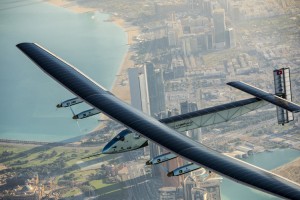Sunny Solar Impulse 2
August 2, 2016

Solar Impulse 2 flies over Abu Dhabi during test flights before the start of the plane’s record-setting journey around the world.
Credit: © Solar Impulse
Last week, on July 26, the solar-powered airplane Solar Impulse 2 landed in Abu Dhabi in the United Arab Emirates, completing the first-ever zero-fuel flight around Earth. Swiss pilot Bertrand Piccard flew the final leg from Cairo, Egypt, to Abu Dhabi’s Al-Bateen Executive Airport, a grueling 48½-hour journey buffeted by hot desert air-driven turbulence. Speaking from the runway tarmac, a tired Piccard commented: “I hope people will understand that it is not just a first in the history of aviation, but also a first in the history of energy… These [clean] technologies now can make the world much better and we have to use them, not only for the environment, but also because they are profitable and create jobs.” Piccard has made aviation news before. In 1999, he completed the world’s first non-stop balloon flight around the world.
Piccard thanked the large Solar Impulse ground team as well as fellow Swiss pilot André Borschberg, who was the first to greet Piccard out of the cockpit. Piccard and Borschberg took turns at the controls during the long legs of the round-the-world flight. The cockpit of Solar Impulse 2 is large enough for just one person at a time. The circumnavigation, which began in Abu Dhabi in March 2015, was completed in 17 legs covering some 26,000 miles (42,000 kilometers) and more than 500 flight hours. Along the way, Solar Impulse 2 set numerous solar-powered flight records, but it also set the general aviation record for longest solo flight—a brutal 4-day, 21-hour, and 51-minute journey made by Borschberg from Japan to Hawaii.
Solar Impulse 2 was built in Switzerland and first flew in 2014. The aircraft flies at an average speed of 44 miles (70 kilometers) per hour. Lithium batteries charged by more than 17,000 solar cells power the plane’s four propeller engines. The cells are located in the aircraft’s 236-foot- (72-meter-) wide wings. The carbon fiber plane weighs about as much as a car, some 5,000 pounds (2.3 metric tons). The cockpit measures just 41 square feet (3.8 square meters) and snugly fits the pilot and reclining chair (which includes a toilet feature), along with flight instruments, computers, food, water, and other supplies. There is no automatic pilot, but a rudimentary electronic co-pilot keeps the plane steady enough for catnaps. Flashing lights in the pilot’s goggles and other alarms wake the aviator if the plane suddenly changes course.
The first Solar Impulse, a smaller demonstration aircraft meant to test the technology, flew safely from 2010 to 2013. It is in storage at Dübendorf Air Base near Zurich.


